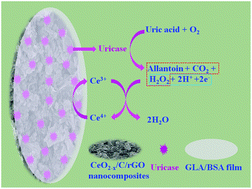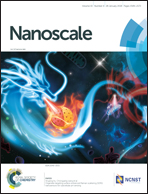CeO2−x/C/rGO nanocomposites derived from Ce-MOF and graphene oxide as a robust platform for highly sensitive uric acid detection†
Abstract
Developing suitable substrate materials is of significance in constructing electrochemical biosensors for fast and reliable quantification of molecules of chemical and biomedical interest. For practical applications, biosensors working at low negative potentials have the advantage of high selectivity and sensitivity. In this work, CeO2−x/C/rGO nanocomposites have been synthesized through the pyrolysis of metal organic frameworks with graphene oxide. The CeO2−x/C/rGO nanocomposites exhibit excellent catalytic properties towards H2O2, which is one of the uricase catalyzed intermediates at low working potentials due to the coexistence of Ce3+ and reduced graphene oxide (rGO). A novel biosensor based on the CeO2−x/C/rGO nanocomposites has been developed and utilized for the detection of uric acid, an important molecule in the biological and medical fields. The biosensor based on the CeO2−x/C/rGO nanocomposites presents a high sensitivity of 284.5 μA cm−2 mM−1 at −0.4 V (vs. SCE), a wide linear range between 49.8 and 1050.0 μM and a low detection limit of 2.0 μM. Moreover, it is found that the amperometric responses are free from interference of ascorbic acid and urea, which shows a great potential for practical applications.



 Please wait while we load your content...
Please wait while we load your content...